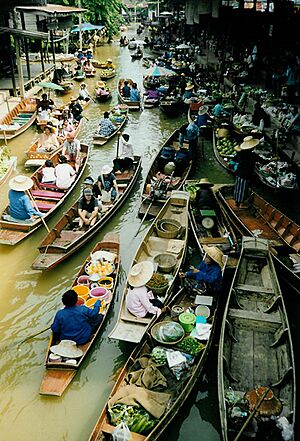Waterway facts for kids
A waterway is like a special path made of water that people can use to travel or move things around using boats. Think of it as a watery road! These watery paths can be natural, like rivers, lakes, and even oceans, or they can be man-made, like canals.
For a body of water to be a waterway, it needs to be wide and deep enough for boats to move safely. It also needs to be mostly smooth, without too many waterfalls or fast-moving rapids that would block boats. If there are obstacles like waterfalls, engineers often build special structures called locks to help boats go around them or move between different water levels.
Contents
What Are Waterways?
Waterways are essential for connecting places and moving goods and people. They have been used for thousands of years, helping civilizations grow and trade with each other.
Natural Waterways
Natural waterways are bodies of water that exist naturally on Earth.
- Rivers: These are flowing waterways that usually start in mountains or hills and flow towards a lake, ocean, or another river. Rivers like the Nile, Amazon, and Mississippi have been vital for transport and settlement for centuries.
- Lakes: Large bodies of still water, lakes can also be important waterways, especially if they are big enough for boats or connect to rivers and canals. The Great Lakes in North America are a good example, allowing ships to travel between different states and Canada.
- Oceans and Seas: The largest natural waterways are the oceans and seas, which cover most of our planet. They allow huge ships to travel between continents, carrying goods and people all over the world.
Man-Made Waterways: Canals
Canals are artificial waterways dug by people to connect natural bodies of water or to create new routes where none existed. They are often built to make travel shorter or easier.
- Connecting Rivers: Some canals connect two rivers, making it possible to travel across land by water.
- Shortening Sea Routes: Famous canals like the Suez Canal and the Panama Canal were built to dramatically shorten sea voyages, saving ships thousands of miles and weeks of travel time.
How Waterways Are Used
Waterways play a huge role in our world, even today.
Transportation and Trade
One of the main uses of waterways is for transportation.
- Moving Goods: Large ships and barges can carry huge amounts of cargo, like grain, oil, cars, and raw materials, often more cheaply than by road or rail. This is especially true for heavy or bulky items.
- Passenger Travel: While planes and trains are common for long-distance passenger travel, boats are still used for ferries, cruises, and local transport, especially in cities built along rivers or coasts.
Recreation and Tourism
Waterways are also popular for fun activities.
- Boating and Fishing: Many people enjoy boating, kayaking, and fishing on rivers, lakes, and coastal waters.
- Cruises: Large cruise ships offer vacations on the ocean, visiting different countries and islands. River cruises are also popular, allowing people to see cities and landscapes from a unique perspective.
Overcoming Challenges on Waterways
Not all natural waterways are perfect for boats. Sometimes, engineers need to build special structures to make them navigable.
Locks and Dams
- Locks: A lock is like a water elevator for boats. It's a chamber with gates at both ends. When a boat enters, the water level inside the lock can be raised or lowered to match the water level on the other side, allowing the boat to continue its journey. This is how boats can pass waterfalls or move between different elevations on a river or canal.
- Dams: While dams are primarily built to control water flow, generate electricity, or store water, they can also create deeper, calmer sections of rivers that are easier for boats to use. Many dams include locks to allow boats to pass.
Importance of Waterways Today
Waterways remain incredibly important for many reasons:
- Economic Growth: They support global trade and industries by providing efficient ways to move goods.
- Environmental Benefits: Water transport can sometimes be more fuel-efficient and produce less pollution per ton of cargo than other forms of transport.
- Historical Significance: Many major cities around the world grew up along waterways because they were vital for trade and communication.
Images for kids



